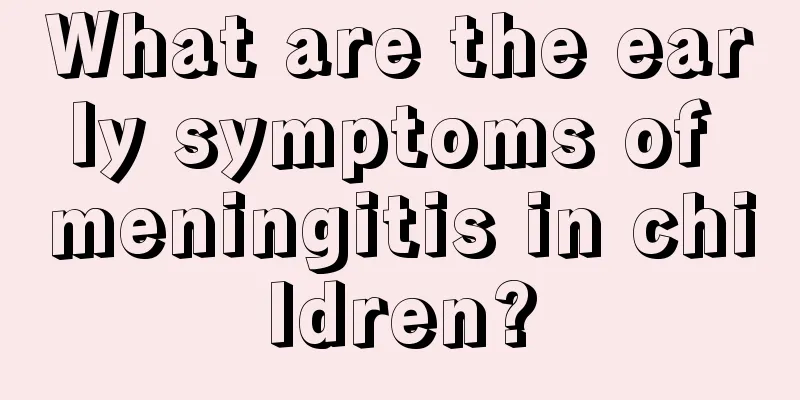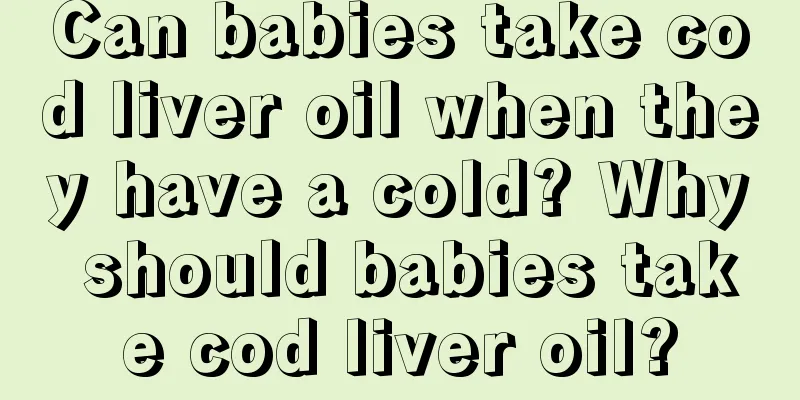What are the early symptoms of meningitis in children?

|
Newborns are prone to illness due to their reduced resistance, but some symptoms are very similar to the common cold, so they do not attract enough attention from parents. Today, I will introduce a disease that is easily confused with the common cold, meningitis. If the following symptoms occur, parents must seek medical attention in time. Symptoms of meningitis1. There are three layers of membranes outside the brain. The one close to the brain is called the pia mater, the outermost layer is the dura mater, and the middle layer is the arachnoid mater. When encephalitis affects the pia mater, symptoms and signs of meningitis may also appear; similarly, when the meninges are inflamed and involve the brain substance, symptoms and signs of encephalitis may also appear. Therefore, sometimes doctors diagnose encephalitis or meningitis, or meningoencephalitis (that is, both). The pathogens that cause encephalitis and meningitis are very extensive, including bacteria, viruses, molds, parasites, etc., and the most common ones are bacteria and viruses. There are various bacteria such as cocci and bacilli among bacteria, and there are also various types of viruses. Clinically, meningitis caused by meningococci is called an epidemic characteristic. Type B encephalitis among viruses is also contagious and often occurs in summer. Regardless of which type of bacteria or virus causes encephalitis or meningitis, the basic symptoms are similar, such as fever, headache, vomiting, drowsiness, mental fatigue and even convulsions. The older the child is, the more obvious the above symptoms are. The symptoms shown by infants are not obvious, sometimes only fever, convulsions or vomiting, and irritability when the fever is high. 2. Due to the increase in intracranial pressure caused by inflammation, the baby's fontanelle is full and protruding. Doctors often find that the child's neck is stiff during examination, that is, when the head is bent forward, the lower jaw cannot touch the chest, or the lower limbs can touch the chest and the two lower limbs change from straight position to flexion. This phenomenon indicates that the meninges are stimulated by inflammation, which indirectly indicates the presence of meningitis. In encephalitis, drowsiness, confusion or coma are prominent symptoms. Whether it is encephalitis or meningitis, convulsions of the limbs may occur. Once a child has the above symptoms, he should go to the hospital for diagnosis and treatment immediately. Don't think that fever and vomiting may be gastroenteritis, or fever and headache may be a cold. When the doctor thinks that a lumbar puncture is necessary, parents should not worry too much. 3. After lumbar puncture to extract cerebrospinal fluid, a clear diagnosis can be made after testing to determine which type of bacterial infection it is, so as to decide which drug to use for treatment. Only early diagnosis and early treatment can save lives in time and reduce sequelae and complications. Symptoms of encephalitis in children1. Children in the prodromal phase have symptoms such as fever, headache, myalgia, vomiting, and diarrhea. 2. Symptoms of encephalitis vary in severity, and are mainly manifested as neuropsychiatric abnormalities. Neurological abnormalities often include fever, headache, vomiting, drowsiness, coma, convulsions, etc. In severe cases, symptoms of the brain, hypothalamus, basal ganglia, brainstem, cerebellum and spinal cord may all be abnormal. Psychiatric abnormalities include excitement, talkativeness, irritability, crying and laughing at random, insomnia, abnormal behavior, hallucinations, fantasies, or indifferent expression, silence, reduced activity, refusal to eat, poor orientation, memory loss, incontinence, etc. 3. Associated symptoms: Symptoms of corresponding viral infection occur before or simultaneously with the onset of encephalitis. Symptomatic treatment 1. When the fever is high, the room temperature should be lowered (controlled at 26-28℃). Physical cooling can be performed on the patient, such as alcohol bath, warm water bath or ice pack. Analgin can be used for nasal drops or intramuscular injection of Bupleurum. If the fever persists or is accompanied by convulsions, sub-hibernation therapy can be used (using chlorpromazine and promethazine 0.5-1 mg/kg each time, intramuscular injection once every 4-6 hours. 2. To control convulsions, antispasmodics can be used, such as phenobarbital sodium 5-8 mg/(kg.time), intramuscular injection; diazepam 0.1-0.3 mg/(kg.time), intramuscular injection or intravenous injection, but it should not be used immediately after phenobarbital to prevent respiratory depression; chloral hydrate 40 mg/(kg.time), retention enema; paraformaldehyde 0.15-0.2 ml/(kg.time), intramuscular injection, the maximum dose should not exceed 5 ml. The above antispasmodics can be used once every 4-6 hours and rotated. In addition, if the convulsion is caused by cerebral edema, dehydration drugs should be given; if it is caused by respiratory secretion blockage, insufficient ventilation and brain cell hypoxia, sputum suction, oxygen administration, tracheotomy and pressurized breathing should be performed if necessary; if it is caused by high fever, cooling treatment should be given. 3. Treatment of respiratory failure First, analyze the cause of respiratory failure and take emergency measures. Keep the airway open and give oxygen. Dehydrating agents, adrenocortical hormones, respiratory stimulants, etc. can be used for patients with respiratory failure due to brain parenchymal inflammation, cerebral edema, and brain hernia. What are the symptoms of meningitis?1. High fever (>40℃), stiff neck, severe headache, loss of appetite, unconsciousness, vomiting, convulsions, fatigue, drowsiness, sensitivity to light, small blood spots on the skin, and skin rash. Experts warn that these symptoms of meningitis are similar to those of a cold, which is often the cause of misdiagnosis. Changes in meningitis symptoms may occur within one to two days, and some may be life-threatening after a few hours. 2. In infants and newborns, high fever, headache, and stiff neck are not typical symptoms, and sometimes low temperature may occur instead. Experts warn that infants and young children with meningitis usually have sharp and continuous crying, unusual drowsiness, poor appetite, extreme sensitivity, and some have swollen fontanelles. 3. In the elderly, the above symptoms may or may not appear, but they may show latent symptoms such as confusion and dullness. 4. Severe bacterial meningitis may also cause symptoms such as shock, coma or convulsions {similar to epilepsy}. 5. Based on long-term clinical experience, brain experts have concluded that when suffering from meningitis, purulent exudates are prone to block narrow passages or adhesions, causing cerebrospinal circulation disorders and hydrocephalus. This is common in patients who are treated improperly or too late, especially in newborns and infants. Adhesive arachnoiditis is prone to occur in the foramen magnum, which can hinder the circulation of cerebrospinal fluid; or adhesions formed by ventricular meningitis are common causes of obstructive hydrocephalus. This symptom can cause great harm to patients. 6. In addition to water and electrolyte disorders caused by vomiting and insomnia, cerebral hyponatremia can also occur, with symptoms such as sleep disturbance, convulsions, coma, edema, general weakness, low muscle tension in the limbs, and oliguria. The mechanism of its occurrence is related to the infection affecting the posterior pituitary gland, causing excessive secretion of antidiuretic hormone and leading to water retention. 7. Due to brain parenchymal damage and adhesion, cranial nerves may be affected or limb paralysis may occur. Brain abscess, intracranial arteritis and secondary epilepsy may also occur. Fulminant meningitis may be accompanied by DIC and shock. In addition, otitis media, pneumonia and arthritis may also occur occasionally. The above are the main symptoms of meningitis, and I believe everyone has learned about them. Experts remind parents in particular to keep these symptoms in mind. Once a child shows symptoms of meningitis, they should go to the hospital for diagnosis and treatment in time to avoid serious consequences. |
<<: What to do if a newborn baby hiccups? What to do if a newborn baby hiccups
Recommend
What services are included in a doula delivery? Does a doula delivery require an episiotomy?
Before giving birth, many mothers heard that the ...
How much influence does a father have on his children? Is it important for a father to accompany his children?
Did you grow up with your father and mother by yo...
Can babies drink cold milk in summer? Symptoms of babies drinking cold milk
The gastrointestinal function of newborn babies i...
Can a newborn baby with hiccups be held in an airplane? What is an airplane hold?
Hiccups in newborns are very common, and almost a...
How to stimulate your baby's visual, auditory and tactile development
Babies are growing up every day. What parents car...
How much is a box of Tianxi Pills? How much is a bottle of Tianxi Pills?
Many women who are eager to have children will ch...
How to prevent adenoids hypertrophy in children What are the effects of adenoids hypertrophy in children
Adenoid hypertrophy in children is a physiologica...
I have a dull pain in my stomach when I am 2 months pregnant. What is the reason for the pain in my stomach when I am 2 months pregnant?
Some new mothers experience dull abdominal pain i...
What is a doula birth like? The whole process of a doula birth
Childbirth is a difficult process. With the advan...
The difference between Libai soap and laundry detergent. Which one is better?
Liby's laundry detergent products include not...
Does anemia in children mean iron deficiency? Do anemia in children make them more likely to get sick?
Usually, it is normal for children to have anemia...
Can pregnant women drink rice wine? Is it good for pregnant women to drink sweet wine?
Rice wine not only tastes good, but also has very...
What are the benefits of natural childbirth for mothers?
There are many benefits of natural childbirth, su...
Can children with colds and fever take a bath? Can children with colds and fever use air conditioning?
It is quite common for children to get sick with ...
What should I do if my baby's fontanelle closes too early? What are the dangers of premature closure of my baby's fontanelle?
There are certain disadvantages if the baby's...









